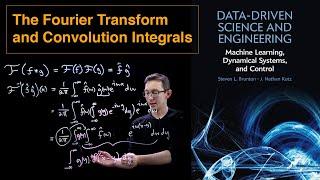
The Fourier Transform and Convolution Integrals
Комментарии:

"My red integral" I guess Steve might be color blind, or I am color blind
Ответить
There is a LOT to be said about the commutative property of the integrals. But I am sure simple minded physicists don't mind.
Ответить
Massively simplify this "convoluted" expression :D
Ответить
I thought it was 1/sqrt(2pi)?
That’s what my professor taught us

Holy moly I've never found math so satisfying
Ответить
I like your videos but this is definitely not a rigorous mathematical setting for the problem.
Engineers would like it but mathematicians will doubt alot of assumptions you already did in the proof.

@SteveBrunton Hallow, professor Steve. A wonderful vide series with precise and definite explanation. First of all, thank you and your team. Now coming to my question and that is why do we need convolution ? We had function multiplication operation before but even then why we had to invent Convolution, what's the advantage and purpose of convolution ?
Ответить
Where does one use this property in physical applications?
Ответить
Great series on FT's and FS's but It would be awesome to include dirac delta function in this lecture series
Ответить
I love this. I’m giving a crash course of DFT to my younger colleague, where I’m fuzzy on some theorem derivations.
Ответить
you saved my homework
Ответить
SO HELPFUL CUM THANKS
Ответить
Who is this guy, why can he write in mirror like nobody's business?
Ответить
Great vid
Ответить
i love u just survived my breakdown thank you seriously thank you
Ответить
Great video! Thanks Steve. I've learnt so much from your lectures.
Ответить
Fantastic representation!
Ответить
Wait, this guy is writing upside down? Pretty useful video btw
Ответить
saved my life! Thanks
Ответить
Also, something else that I think needs to be addressed is the way that EVERYONE describes the difference between correlation and convolution. In the time domain, one of the functions is time reversed for convolution. But, and this is a big BUT, in the frequency domain it is when we are performing a cross-correlation that one of the DFTs is conjugated (equivalent to time reversal in the time domain). It took me a long time to sort this inherent ambiguity out. This ambiguity needs to be recognized. To assume that everyone realizes this is a big mistake.
Ответить
It is not intuitively obvious to me that the in the formula for convolution ( sum over k (f(t)*g(t-k) ) that g(t-k) implies that it is time reversed. That is not obvious. What part of the formula for convolution (in the time domain) implies that one of the functions is reversed in time?
Ответить
With convolution in the time domain, we have to time reverse one of the functions before we do the convolution. When we do the convolution in the frequency domain(multiplication in frequency domain) do we have to time reverse one of the functions before we take its fourier transform? If not, why not?
Ответить
Its a liiitle bit convoluted . Smooth explanation, I havent done convolution integrals yet but i understood this
Ответить
The aesthetics in this video are crazy good but a bit unsettling lol
Ответить
Thank you so much for this embellished presentation. I got a doubt, what is the diffusion kernel, anyway?
Ответить
На часах 2 часа ночи, но я не могу оторваться. Круто!
Ответить
Subscribed. Took me one second to reason why.
This man describes all the details in an exhaustive manner. This is exactly what many students are searching for. I can't imagine Lebesgue Integration at this level of detail. Even thinking about makes me cry of happiness. . There are many Doctors like him doing an outstanding job.
And this was recommended as a random video.....

Amazing, thanks a lot!
Ответить
K-see
Bless you
K-see
Bless you again

Thank u for ur clear explanation!
Ответить
love this
Ответить
Hahaha. "Rather convoluted expression." I see what you did there.
Ответить
Yes, this is it ))
Ответить
Great one, i want to thank you for your work. And i have also a request : can you make for us some videos about the following topics: Fast fourrier transforme (FFT) and the integrator operation. Thank you in advance.
Ответить
your in-depth explanation of complex concepts is phenomenal. thank you
Ответить
Steve, Big fan of your lectures.
Ответить
















